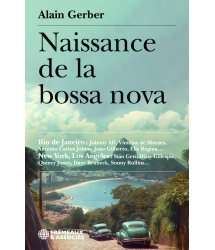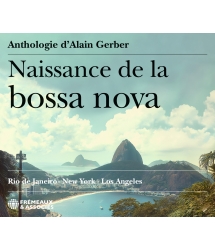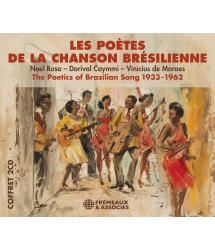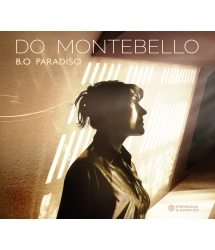- Our Catalog
- Philosophy
- Philosophers of the 20th century and today
- History of Philosophy (PUF)
- Counter-History and Brief Encyclopedia by Michel Onfray
- The philosophical work explained by Luc Ferry
- Ancient thought
- Thinkers of yesterday as seen by the philosophers of today
- Historical philosophical texts interpreted by great actors
- History
- Books (in French)
- Social science
- Historical words
- Audiobooks & Literature
- Our Catalog
- Jazz
- Blues
- Rock - Country - Cajun
- French song
- World music
- Africa
- France
- Québec / Canada
- Hawaï
- West Indies
- Caribbean
- Cuba & Afro-cubain
- Mexico
- South America
- Tango
- Brazil
- Tzigane / Gypsy
- Fado / Portugal
- Flamenco / Spain
- Yiddish / Israel
- China
- Tibet / Nepal
- Asia
- Indian Ocean / Madagascar
- Japan
- Indonesia
- Oceania
- India
- Bangladesh
- USSR / Communist songs
- World music / Miscellaneous
- Classical music
- Composers - Movie Soundtracks
- Sounds of nature
- Our Catalog
- Youth
- Philosophy
- News
- How to order ?
- Receive the catalog
- Manifesto
- Dictionnary











- Our Catalog
- Philosophy
- Philosophers of the 20th century and today
- History of Philosophy (PUF)
- Counter-History and Brief Encyclopedia by Michel Onfray
- The philosophical work explained by Luc Ferry
- Ancient thought
- Thinkers of yesterday as seen by the philosophers of today
- Historical philosophical texts interpreted by great actors
- History
- Books (in French)
- Social science
- Historical words
- Audiobooks & Literature
- Our Catalog
- Jazz
- Blues
- Rock - Country - Cajun
- French song
- World music
- Africa
- France
- Québec / Canada
- Hawaï
- West Indies
- Caribbean
- Cuba & Afro-cubain
- Mexico
- South America
- Tango
- Brazil
- Tzigane / Gypsy
- Fado / Portugal
- Flamenco / Spain
- Yiddish / Israel
- China
- Tibet / Nepal
- Asia
- Indian Ocean / Madagascar
- Japan
- Indonesia
- Oceania
- India
- Bangladesh
- USSR / Communist songs
- World music / Miscellaneous
- Classical music
- Composers - Movie Soundtracks
- Sounds of nature
- Our Catalog
- Youth
- Philosophy
- News
- How to order ?
- Receive the catalog
- Manifesto
- Dictionnary
ANTHOLOGIE DES MUSIQUES DEDIEES A LA PENSEE ECOLOGIQUE 1941-1962
Charles Trenet • Stan Getz • Dorival Caymmi • Claude Debussy
Ref.: FA5823
EAN : 3561302582320
Artistic Direction : Teca Calazans & Philippe Lesage
Label : FREMEAUX & ASSOCIES
Total duration of the pack : 2 hours 25 minutes
Nbre. CD : 2
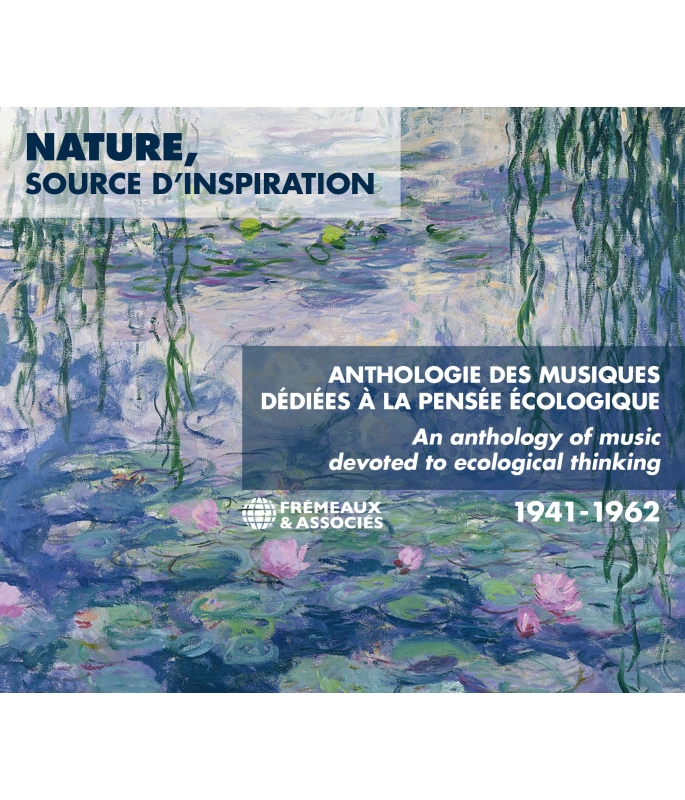
ANTHOLOGIE DES MUSIQUES DEDIEES A LA PENSEE ECOLOGIQUE 1941-1962
ANTHOLOGIE DES MUSIQUES DEDIEES A LA PENSEE ECOLOGIQUE 1941-1962
Before the Sixties, notions like the Anthropocene epoch, the philosophy of living in harmony with nature, the recognition of nature’s rights, climatic change, even less the sombre predictions of the collapsology described by Pablo Servigne, or the solastalgia in Glenn Albrecht’s definition, weren’t concepts that muddied the learned discourse of scientists or the media. Even if one could sense a sketchy idea of ecology’s humanities that lay just over the horizon, Nature, above all else, was a source of inspiration. So the musical path trodden by Debussy, Trenet, Django Reinhardt, Brassens, Duke Ellington, Hoagy Carmichael, Chico Hamilton, Stan Getz, Miles Davis and Dorival Caymmi relates the story of the artistic sensibilities that surround the seasonal cycle, the melancholy born of rainfall, the symbolism of trees and the sea, the fear of storms, and life close to animals.
Teca CALAZANS & Philippe LESAGE
CD1 : MADAME LA PLUIE (CHARLES TRENET) • L’EAU VIVE (GUY BÉART) • LA MER (CHARLES TRENET) • NUAGES (DJANGO REINHARDT) • SONGE D’AUTOMNE (DJANGO REINHARDT) • VERLAINE (CHARLES TRENET) • MÉLODIE AU CRÉPUSCULE (DJANGO REINHARDT) • QUAND REFLEURIRONT LES LILAS BLANCS ? (HENRI CROLLA) • UNE NOIX (CHARLES TRENET) • LE PETIT CHEVAL (GEORGES BRASSENS) • LA CANE DE JEANNE (GEORGES BRASSENS) • LE VENT (LÉO FERRÉ) • LE VENT (GEORGES BRASSENS) • AUPRÈS DE MON ARBRE (GEORGES BRASSENS) • L’OMBRE (JULIETTE GRÉCO) • QUAND ON S’PROMÈNE AU BORD DE L’EAU (JEAN GABIN) • HYMNE AU PRINTEMPS (FÉLIX LECLERC) • E DOCE MORRER NO MAR (DORIVAL CAYMMI) • O VENTO (DORIVAL CAYMMI) • O BEM DO MAR (DORIVAL CAYMMI) • NOITE DE TEMPORAL (DORIVAL CAYMMI) • CANOEIRO (DORIVAL CAYMMI) • O MAR (DORIVAL CAYMMI) • COQUEIRO DE ITAPOAN (DORIVAL CAYMMI) • LA MER, 3E MOUVEMENT (CLAUDE DEBUSSY).
CD2 : O BARQUINHO (JOÃO GILBERTO) • O PATO (JOÃO GILBERTO) • A SUMMER AFTERNOON (STAN GETZ) • NATURE BY EMERSON (CHICO HAMILTON) • LOTUS BLOSSOM (JOHNNY HODGES) • BYE BYE BLACKBIRD (MILES DAVIS) • SEPTEMBER SONG (CHET BAKER) • SEPTEMBER IN THE RAIN (BING CROSBY) • WINTER MOON (HOAGY CARMICHAEL) • SKYLARK (HOAGY CARMICHAEL) • ESTRADA DO SOL (SYLVIA TELLES) • STORMY WEATHER (ROLAND KIRK) • FOGGY, FOGGY DEW (FRED KATZ) • FONTAINEBLEAU FOREST (DUKE ELLINGTON) • LES SONS ET LES PARFUMS - PRÉLUDE (DEBUSSY / MARCELLE MEYER) • LE VENT DANS LA PLAINE - PRÉLUDE (DEBUSSY / MARCELLE MEYER) • NUAGES - NOCTURNES (DEBUSSY / CHARLES MUNCH) • LEVER DU JOUR (RAVEL / ANDRÉ CLUYTENS).
DIRECTION ARTISTIQUE : TECA CALAZANS ET PHILIPPE LESAGE
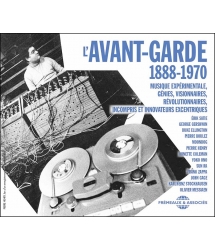
MUSIQUE EXPÉRIMENTALE, GÉNIES, VISIONNAIRES,...
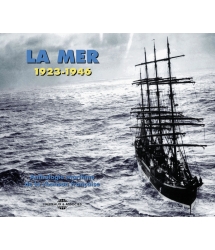
ANTHOLOGIE MARITIME DE LA CHANSON FRANCAISE
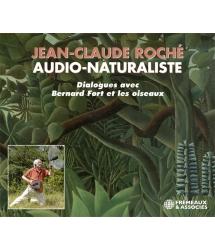
DIALOGUES AVEC BERNARD FORT ET LES OISEAUX
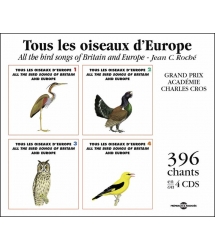
ALL THE BIRDS SONGS OF BRITAIN AND EUROPE




-
PisteTitleMain artistAutorDurationRegistered in
-
1Madame la pluieCharles TrenetCharles Trenet00:02:271953
-
2'L''eau Vive'Guy BéartGuy Béart00:02:451958
-
3La merCharles TrenetCharles Trenet00:02:451946
-
4NuagesDjango ReinhardtDjango Reinhardt00:03:161953
-
5'Songe d''automne'Django Reinhardt.Django Reinhardt00:03:011947
-
6VerlaineCharles TrenetPaul Verlaine00:03:241941
-
7Melodie au crépusculeDjango Reinhardt.Django Reinhardt00:03:121946
-
8Quand refleuriront les lilas blancsHenri CrollaFranz Dolle00:01:491955
-
9Une noixCharles TrenetCharles Trenet00:02:441951
-
10Le petit chevalGeorges BrassensPaul Fort00:02:201953
-
11La cane de JeanneGeorges BrassensGeorges Brassens00:01:271954
-
12Le VentLéo FerréLéo Ferré00:03:251960
-
13Le ventGeorges BrassensGeorges Brassens00:01:151954
-
14Auprès de mon arbreGeorges BrassensGeorges Brassens00:03:061956
-
15'L''ombre'Juliette GrécoFrançois Mauriac00:02:441951
-
16'Quand on s''promène au bord de l''eau'Jean GabinMaurice Yvain00:03:161936
-
17Hymne au printempsFélix LeclercFélix Leclerc00:02:271951
-
18E doce morrer no marDorival CaymmiDorival Caymmi00:03:361957
-
19O ventoDorival CaymmiDorival Caymmi00:03:321957
-
20O bem do marDorival CaymmiDorival Caymmi00:03:131957
-
21Noite de temporalDorival CaymmiDorival Caymmi00:03:521957
-
22CanoeiroDorival CaymmiDorival Caymmi00:02:461957
-
23O marDorival CaymmiDorival Caymmi00:03:261957
-
24Coqueiro de itapoanDorival CaymmiDorival Caymmi00:03:581957
-
25Claude Debussy - La mer, 3e mouvementRoger DésormièreClaude Debussy00:08:001950
-
PisteTitleMain artistAutorDurationRegistered in
-
1O barquinhoJoão GilbertoRoberto Menescal00:02:311961
-
2O patoJoão GilbertoJaime Silva00:01:591960
-
3A Summer AfternoonStan GetzEddie Sauter00:06:001961
-
4Nature By EmersonChico HamiltonFred Katz00:05:041958
-
5Lotus BlossomJohnny HodgesBilly Strayhorn00:03:031947
-
6Bye Bye BlackbirdMiles DavisRay Anderson00:07:561956
-
7September SongChet BakerMaxwell Anderson00:03:031959
-
8September In The RainBing CrosbyAl Dubin00:02:561956
-
9Winter MoonHoagy CarmichaelHoagy Carmichael00:04:121959
-
10SkylarkHoagy CarmichaelHoagy Carmichael00:04:021959
-
11Estrada do solSilvia TellesDolores Duran00:02:281961
-
12Stormy WeatherRoland KirkArlen00:04:361956
-
13Foggy, Foggy DewFred KatzFred Katz00:05:201958
-
14Fontainebleau ForestDuke EllingtonDuke Ellington00:02:521960
-
15Claude Debussy - Préludes - Livre I - Les sons et les parfumsMarcelle MeyerClaude Debussy00:02:511957
-
16Claude Debussy - Préludes - Livre I - Le vent dans la plaineMarcelle MeyerClaude Debussy00:01:591957
-
17Claude Debussy - Nocturnes - NuagesMarco FerraraClaude Debussy00:01:591962
-
18Maurice Ravel - Lever du jourAndré CluytensMaurice Ravel00:05:121953
Nature, a source of inspiration
An anthology of music devoted to ecological thinking, 1941-1962
Communion with nature
If the composition Nature By Emerson is present in our anthology, it’s because it illustrates the tone of the subject: nature as a source of inspiration and an overture to ecological thinking. It was immediately after reading the essay Nature written by Ralph Waldo Emerson, the high priest of transcendentalism, that cellist Fred Katz, who was also the musical director of the Chico Hamilton Quintet, confessed he felt the pressing need to capture its spirit in music. His fellow American Charles Ives (1874 – 1954), another composer equally sensitive to that message, didn’t miss the opportunity to point out that Henry David Thoreau and John Muir, two other essential thinkers in the domain of ecology, attributed a fundamental importance to the music of nature (and Ives, incidentally, would compose a Sonata for Piano N° 2 whose movements carry titles with the names of transcendental thinkers – Emerson, Hawthorne, Alcott and Thoreau – as well as songs based on poems by Emerson.)
Wilderness, or the wild in nature
In his essay published un 1836, Emerson states that every man is tied to nature and regenerated by it; the thesis is also illustrated by his disciple Thoreau, in his journal Walden, or, Life in the Woods. In this way, both thinkers imposed a shift in the reflexion on their times: nature is not thought of as being against the culture and rationality of the Lumières, rather as against any industrial civilisation that destroys the environment. Translated concretely: nature becomes a space to be protected. It would bring Aldo Leopold (1887–1948) to launch modern environmental ethics by being at the origin of the creation of our national parks. That desire to “protect nature’s cathedrals” (the formula is John Muir’s) would give rise to the concept of wilderness that imposes protecting nature as a priority, indeed, as an unconditional act. Karl Jacoby also seized the chance to demonstrate its limits in his essay Crimes against Nature, where he underlined the violence committed in nature’s name with regard to natives and squatters.
The concept of nature, a cultural construction
In those Twenties of our twenty-first century there was fierce debate. The anxieties of the present followed the rising curve of the risks linked to global warming. Philosophers (Baptiste Morizot, Vinciane Despret, Dominique Quessada), ethnologists (Philippe Descola, Natassja Martin), sociologists (Bruno Latour…), scientists (Pablo Servigne, Glenn Albrecht), elected politicians (José Bové, Nicolas Hulot), ethnobotanists (Pierre Lieutaghi) and geographers (Raphaël Mathevet…) would hack away at each other to the point of falling into the extreme visions of solastalgia (“eco-anxiety” in Glenn Albrecht’s analysis) and collapsology (which according to Pablo Servigne studies the collapse of industrial civilisations to come.) Less pessimistic, and far from any narrow moralism, Baptiste Morizot, like a number of today’s thinkers, would defend other ties and a more understanding perspective when considering other forms of life.
The absence of a universal concept
The appearance of ecology as a subject for reflexion and study is relatively recent. It dates back to 1866, when the German biologist Ernst Haeckel coined the term in creating a scientific discipline that studied the dynamics of populations and settlements (animal, vegetal and microbial) in addition to the functions of ecosystems and landscapes. Since then, disputes over cataclysmic climatic consequences have greatly increased. Political decisions have been taken: with impetus from the United Nations Program, an inter-governmental experts’ group (GIEC) was set up and the first COP took place in Stockholm in 1988. The Earth Summit followed in Rio de Janeiro in 1992, and the first Climate Conference was held in Berlin in 1995. The conviction that it is Nature that determines Man’s fate became the norm in the western world without it being possible to mask the absence of a universal concept, so true was it that the concept of Nature is a cultural construction.
Nature as a source of artistic inspiration
Let there be no mistake: this anthology is more a sort of cartography of the ways in which artists draw inspiration from nature, rather than a musical illustration of the debate surrounding ecology. And this is for a simple reason: awareness of the fragility of living things, and ecology’s appearance as a subject for reflexion and study, weren’t in fashion (in politics, the media or the arts) until 1962, which is the cut-off date that limits the scope of our anthology here. That is why our selection takes inspiration above all from the works of the neuropsychiatrist Boris Cyrulnik and the historian Alain Corbin, for whom Nature is the imprint of Man’s sensibilities and likings; the affective life of artists therefore depends as much on the outside world, and on their interactions with their milieu, as it does on their inner selves.
From the 19th century (Beethoven, Schubert, Schumann and Liszt come to mind) until the 1960’s, artists were sensitive to seasonal cycles and the beauty of the light that shone on different landscapes as demonstrated in the compositions of Debussy and Ravel, or those of Django Reinhardt and Charles Trenet, to name only four. So in this anthology there are no protest songs to be found that explicitly advocate against the catastrophes for which Man might be held responsible.
The Little Horse,
or the Animal as a Partner of Existence
Since animals are partners of our existence, songs do not forget that fact even if they often treat animals with compassion, as in Le Petit Cheval, the Paul Fort poem set to music by Georges Brassens. This song couldn’t fail to move Hicham-Stéphane Afeissa, a specialist in environmental and animal philosophy; according to the latter, we must cease to look on animals as our fellow creatures: we are to leave the domain of primary emotions and turn our backs on the moral landscape of compassion. La Cane de Jeanne is more mischievous, while Skylark and Bye Bye Blackbird are more melancholy. And O Pato (“the duck”), a quick sketch in the form of an anthropomorphic samba, is a pure delight: “The duck came in singing quack-quack, when a toad with a grin asked to join in the samba too. The gander liked the duo, went quack-quack also, and then looked at the swan, telling him a quartet would be nice, and even very nice… Along the edge of the pond, off they went to rehearse, beginning ‘Tico, Tico no Fuba…’”
An Autumn Dream, or The Seasons
Observing the sky and the elements is indeed what makes the inner soul and the soul of the world communicate, to the point where September Song establishes a correlation between the ages of life and the seasonal cycle. And to convince yourself of that osmosis between seasons and emotions you only have to listen to Trenet singing Verlaine, Félix Leclerc’s version of Hymne au printemps, or Winter Moon, Songe d’Automne and Summer Afternoon.
Living water, or the Sea and Fresh Water
Listening to Debussy’s La Mer, but also to Dorival Caymmi, the composer from Bahia, whose magnificent songs translate all the ambivalence of Man’s terror and fascination when facing the ocean, it is impossible not to go back to Baudelaire’s poem L’Homme et La Mer (“Free man, always will you cherish the sea! The sea is your mirror; you contemplate your soul.”) In people’s imaginations, aquatic notions are complex, with salt water as the opposite of fresh water. According to Heraclitus, “panta rhei” or, “everything flows,” and spring water is the manifestation of the irreversible flow of time, but also of the pure and virginal, which is what Guy Béart illustrates in his song L’eau vive.
By his own admission Debussy entertained a special relationship with Nature: “Music does not imitate nature but is its equal: it is an art that is free, outflowing, an art of the open air, an art proportionate to the elements, the wind, the sky and the sea!” And it’s true that the tumult of the sea was in harmony with the rhythm of his rhythmical imagination. As for Dorival Caymmi, the incredible power behind his music and poetry clearly elucidates the ambivalence that holds fishermen in its grip: the sea was their living, yet they would also disappear in its waters. In O Barquinho, the guitarist-composer Roberto Menescal and lyricist Ronaldo Boscôli unveil a vision that has more enchantment, a perspective embedded in the philosophy that typified the period in which the bossa nova was born – the golden youth of Rio de Janeiro taking to the sea aboard a yacht.
Thoughts beneath the clouds
“Clouds remain wonderful objects of fascination and dreams,” wrote Baudelaire. Hence the poet Philippe Jaccottet’s title for the work he published in 1994, Pensées sous les nuages. Listening to Nuages, Debussy’s orchestral nocturne and also Django Reinhardt’s most famous composition, one has a premonition that clouds (“nuages”) might just be the expression of the inconsistencies that cause us to have dreams.
The wind in the plains
Before Lavoisier’s discovery of the composition of air, hurricanes and storms were considered as manifestations of the Gods’ punishments. Ever since air ceased to be a mystery, the wind has told us the story of oblivion, and also energy. To be convinced, listen to O Vento by Dorival Caymmi, or turn to Debussy again, for the prelude Le vent dans la plaine.
Stormy Weather, or Rain, Storm and Fog.
Thoreau magnifies rain as “the gentle rain… good for me too”; for Verlaine, rain had to do with boredom, which he referred as “spleen” (“Oh, the soft noise of rain that falls on the ground and roofs! For a heart that is bored, oh, the song of the rain!”); and with Debussy it took on an air of melancholy, although, he admitted, “one can’t listen enough to the thousand sounds of rain.” In a word, as with Charles Trenet (Madame La Pluie), rain symbolises the ephemeral and the unstable. Fog, like storms (Noite de Temporal by Dorival Caymmi, and Stormy Weather) invade the inner nature of the subject and muddle its traces in fog.
Close to my tree, or the Tree and the Woods
If Auprès de mon arbre, (“Close to my tree”) the Georges Brassens song, has left such a mark on us, it is because beneath the shadows of that tree we can relax and reflect on the cyclical movement of the time it symbolises, as Bachelard pointed out quite pertinently. As for Thoreau, (“I went into the woods because I wished to live deliberately, to front only the essential facts of life”), he seems to agree with Philippe Jaccottet, who wrote, “The tree is a lesson; one can love, reflect, and think, in terms of life rather than knowledge.” The message is not far from songs in general, nor from Duke Ellington’s Fontainebleau Forest.
Teca Calazans and Philippe Lesage
English Adaptation: Martin DAVIES
This anthology is dedicated to historian Alain Corbin,
with thanks for his invaluable advice.
Discographie - La Nature, source d’inspiration
Anthologie des musiques dédiées à la pensée écologique - 1941 - 1962
CD 1
1. Madame La Pluie (Charles Trenet) 2’27
Charles Trenet (chant) - direction d’orchestre et arrangement A Lasry. EMI Pathé -Marconi 7906332 - 1953
2. L’eau Vive (Guy Béart)
Guy Béart (chant). 1958 - 45 t Philips 432.314 BE
3. La Mer (Charles Trenet) 2’45
Charles Trenet (chant) - Direction d’orchestre et arrangement Albert Lasry. 1946 - Columbia SCTX 340464
4. Nuages (Django Reinhardt) 3’16
Django Reinhardt (g), Maurice Vander (p), Pierre Michelot (b), Jean-Louis Viale (batterie) 1953 - Vogue EPL 7066
5. Songe d’Automne (Archibald Joyce) 3’01
Quintet du Hot Club de France : Hubert Rostaing (clarinette), Django Reinhardt (guitare solo), Eugène Vées (guitare), Emmanuel Soudieux (contrebasse), Pierre Fouad (batterie). 1947 - Decca 9243
6. Verlaine (Trenet - Paul Verlaine) 3’24
Charles Trenet (chant) et le Jazz de Paris. 1941 - Columbia BF 217 (CL 7399/400)
7. Mélodie au Crépuscule
(Django Reinhardt - L. Reisner) 3’12
Quintet du Hot Club de France : Stéphane Grappelli (violon), Django Reinhardt (guitare solo), Jack Llewellyn et Allan Hodgkin (guitares), Coleridge Goods (batterie). 1946 - Decca F. 8604)
8. Quand Refleuriront les Lilas Blancs (Franz Dölle) 1’49
Henri Crolla sa guitare et son ensemble : Henri Crolla (g), Lalos Bing (Martial Solal, p), Emmanuel Soudieux (contrebasse), Jacques David (batterie). 1955 - EP Vega 45 1575
9. Une Noix (Charles Trenet) 2’44
Charles Trenet (chant) - direction d’orchestre : Jo Boyer. 1951 - EMI Pathé -Marconi 7906332
10. Le Petit Cheval (Paul Fort - Georges Brassens) 2’20
Georges Brassens (chant et guitare), Pierre Nicolas (contrebasse). 1953 - LP 25 cm « La Mauvaise Réputation » ; Polydor 530.011
11. La Cane de Jeanne (Georges Brassens) 1’27
Georges Brassens (chant et guitare), Pierre Nicolas (contrebasse). 1954 - 25 cm Les Amoureux des bancs publics - Polydor 530.024
12. Le Vent (Léo Ferré) 3’25
Léo Ferré (chant) direction d’orchestre : Jean-Michel Defaye. 1960 - Barclay BA-215
13. Le Vent (Georges Brassens) 1’15
Georges Brassens (chant et guitare). 1954 - 25 cm Les Amoureux des Bancs Publics - Polydor 530.024
14. Auprès de mon arbre (Georges Brassens) 3’06
Georges Brassens (chant et guitare). 1956 - du LP Chanson pour l’auvergnat - Philips 76.064
15. L’Ombre (François Mauriac -Luc Porret) 2’44
Juliette Gréco (chant), Orchestre Jo Boyer. Mars 1951 - 78 t Philips N 72 -123
16. Quand On s’promène au bord de l’eau
(Maurice Yvain - Jean Duvivier) 3’16
Du film La Belle Époque / Jean Gabin (chant) ; direction d’orchestre : Pierrot. 1936 - Pathé Marconi
17. Hymne au printemps (Félix Leclerc) 2’27
LP Félix Leclerc et sa guitare n°2 - André Grassi et son orchestre. 1951 - EPIC LF 2008
18. E Doce Morrer No Mar (Dorival Caymmi) 3’36
Dorival Caymmi : chant et guitare. 1957 - LP Caymmi e seu violão (cançoes praieras). Odeon MOFB 3093
19. O Vento (Dorival Caymmi) 3’32
Dorival Caymmi (chant et guitare). 1957 - LP Caymmi e seu violão (cançoes Praieras)
20. O Bem Do Mar (Dorival Caymmi) 3’13
Dorival Caymmi (chant et guitare). 1957 - LP Caymmi e seu violão (cançoes praieras)
21. Noite de Temporal (Dorival Caymmi) 3’52
Dorival Caymmi (chant et guitare). 1957 - LP Caymmi e seu violão (cançoes praieras)
22. Canoeiro (Dorival Caymmi) 2’46
Dorival Caymmi (chant et guitare). 1957 - LP Caymmi e seu violão (cançoes praieras)
23. O Mar (Dorival Caymmi) 3’26
1957 - LP Caymmi e seu violão (cançoes praieras). Dorival Caymmi (chant et Guitare)
24. Coqueiro de Itapoan (Dorival Caymmi) 3’58
Dorival Caymmi (Chant et guitare). 1957 - LP Caymmi e seu violão (cançoes praieras)
25. La Mer (Claude Debussy) 8’00
Mouvement Dialogue du vent et de la mer. Czech Philarmonic Orchestra ; direction Roger Désormière. Prague, octobre 1950. Supraphon H2331/ 2333
CD2
1. O Barquinho (Roberto Menescal - Ronaldo Boscôli) 2’31
João Gilberto (chant et guitare), Direction, arrangement et piano : Antonio Carlos Jobim. LP João Gilberto. 1961- Odeon MOFN - 3202
2. O Pato (Jayme Silva - Neuza Teixeira) 1’59
João Gilberto (chant et guitare), direction et arrangement : Antonio Carlos Jobim. LP O Amor O Sorriso e A Flor. 1960 - EMI Odeon - 06280162
3. A Summer Afternoon (Eddie Sauter) 6’00
Stan Getz (ts), John Neves (b), Roy Haynes (dr), String ensemble including members ob Beaux- Arts Quartet, conducted by Hershy Kay - composed and arranged by Eddie Sauter. LP Focus. 1961 - Verve -1-2528
4. Nature By Emerson (Fred Katz) 5’04
Chico Hamilton (leader, dr), Dennis Budimir (g), Eric Dolphy (as, fl, bass -cl), Nathan Gershman(cello), Wyatt Ruther (b). LP Gongs East !. 1958 - Warner Bros Records BS - 12715
5. Lotus Blossom (Billy Strayhorn) 3’03
Harold “Shorty” Baker (tp), Johnny Hodges (as), Al Sears (ts), Harry Carney (bs), Billy Strayhorn (p) Oscar Pettitford (b), Sonny Greer (dr). LP Johnny Hodges & His Orchestra. 1947 - HMV 7EG - 8030
6. Bye Bye Blackbird (Ray Anderson -Mort Dixon) 7’56
Miles Davis (tp), John Coltrane (ts), Red Garland (p), Paul Chambers(b), « Philly » Joe Jones (dr). LP ‘Round Midnight. 5 juin 1956 - Columbia CS 8649
7. September Song (Maxwell Anderson - Kurt Weill) 3’03
Chet Baker (tp), Kenny Burrell (g), Paul Chambers (b), Connie Kay (dr). Janvier 59 - Riverside Records BLP 1135
8. September In The Rain (Al Dubin - Harry Warren) 2’56
Bing Crosby (voc), Harry « Sweat » Edison, Pete Candoli, Maynard Ferguson, Conrad Gozzo (tp), Frank Rosolino , Milt Bernhard (tb), Herb Geller, bob Cooper, Ted Nast, Chuck Gentry (reeds), Paul Smith (p), Barney Kessel (g), Joe Mondragon(b), Alvin Stoller (dr) + strings. LP Bing Sings Whilst Bergman Swings. Juin 1956 - Verve EPV -5022
9. Winter Moon (Hoagy Carmichael) 4’12
Hoagy Carmichael (voc), Don Fagerquist, Ray Linn (tp), Jimmy Zito(b-tp), Harry Klee, Art Pepper (as), Mort friedmann (ts), Marty Berman(bs), Jimmy Rowles (p), Al Hendrickson(g), Joe Mondragon (b), Nick Fatool (dr), Marvin Ash (celesta), Johnny Mandel (arr- conductor). LP Hoagy sings Carmichael. 1959 - Pacific Jazz 1223
10. Skylark (Hoagy Carmichael - PF Webster) 4’02
LP Hoagy sings Carmichael
Hoagy Carmichael (voc), même formation que plage précédente. 1959 - Pacific Jazz 1223
11. Estrada do sol
(Antonio Carlos Jobim - Dolores Duran) 2’28
Sylvia Telles (voc), com a orquestra de Bill Hitchcock ; guitare : Barney Kessel. LP USA. 1961 - Philips P -630 -453 L
12. Stormy Weather (Arlen - Koehler) 4’36
Roland Kirk (ts, manzello, stritch), Jimmy Madison (p), Carl Pruitt (b), Henry « Hank » Duncan (dr). LP Third Dimension. 9 novembre 1956 - Bethlelem Records -COSY - 9033
13. Foggy, Foogy Dew (adapted by Fred Katz) 5’20
Fred Katz (conductor, arr, cello), Gene Estes (vibes), Johnny T Williams (p), Mel Pollen (b), Jerry Williams (dr). LP Folks Songs For Far Out Folk. Septembre 1958 - Warner Bros W 1277
14. Fontainebleau Forest (Duke Ellington) 2’52
Duke Ellington(p), Aaron Bell (b), Sam Woodyard (dr). LP Piano In Foreground. 1960 - Columbia CBS 84419
15. Préludes - Livre I - Les Sons et les parfums tournent dans l’air du soir (Claude Debussy) 2’51
Marcelle Meyer (p). 1957 - 33 t Les Discophiles Français DF 211/2
16. Préludes - Livre I - Le vent dans la plaine 1’59
Marcelle Meyer (p). 1957 - Les Discophiles Français DF 211/2
17. Nocturnes - Nuages (Claude Debussy) 7’22
Orchestre Symphonique de Boston, direction Charles Munch
1962 - RCA 7276- FVL3
18. Lever du jour (Maurice Ravel) 5’12
Du ballet Daphnis et Chloë. Orchestre de la Société des Concerts du Conservatoire, direction André Cluytens. 1953 - Columbia FCX - 934
